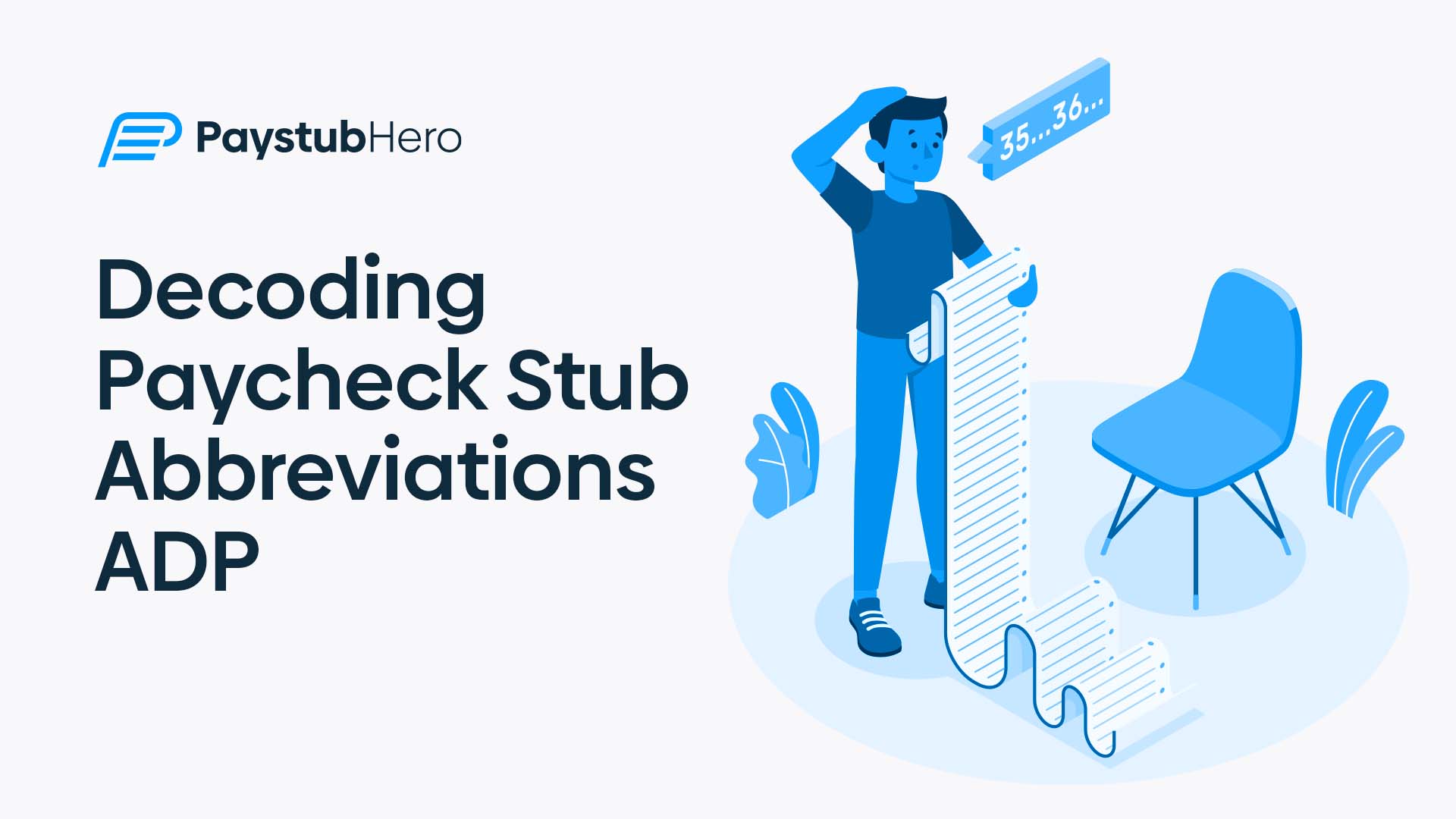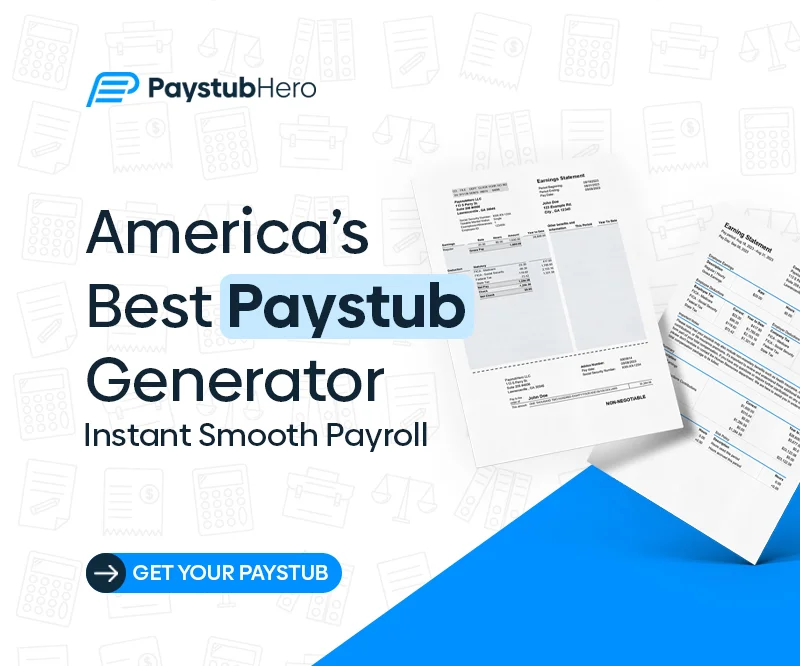Your paycheck stub is packed with abbreviations, like FWT, MED, YTD, or SUI. However, none of them come with a key.
If you use a provider like ADP, these codes can get even more cryptic. But each one tells you something important about your pay, deductions, and taxes.
In this guide, I’ll break down the most common paycheck stub abbreviations, show you what they mean, and help you read your pay stub without second guessing.
What Are Paycheck Stub Abbreviations?
Abbreviations on your pay stub are shorthand for earnings, taxes, and deductions. They’re meant to save space, but they often confuse people.
For example:
|
Abbreviation |
Meaning |
|
FWT |
Federal Withholding Tax |
|
SUI |
State Unemployment Insurance |
|
FICA-MED |
Medicare portion of FICA |
|
YTD |
Year-to-Date totals |
If your employer uses ADP, Paychex, or another payroll provider, the abbreviations may vary slightly, but the main categories remain the same.
Knowing these codes helps you:
⦿ Understand where your money is going
⦿ Catch errors in deductions
⦿ Plan and budget better
Key Paycheck Abbreviations You Should Know
These are the codes you’ll almost always see on a pay stub:
These are the codes you’ll almost always see on a pay stub:
|
Abbreviation |
Meaning |
|
GRS or GRS WAGES |
Gross Wages: Total pay before deductions |
|
FWT |
Federal Withholding Tax |
|
SWT or SIT |
State Withholding Tax |
|
FICA-SS |
|
|
FICA-MED |
Medicare tax (1.45%) |
|
FICA EE/ER |
Employee/Employer portion of FICA taxes |
|
MED or MEDI |
Medicare deduction (may be shown separately) |
|
YTD |
Example:
If your pay stub says:
FWT: $300 | YTD FWT: $4,200
It means $300 was withheld this period, and $4,200 has been withheld so far this year.
Other Common Abbreviations You Might See
These may or may not appear depending on your job, state, or benefits package:
|
Abbreviation |
Meaning |
|
SUI |
State Unemployment Insurance |
|
SDI |
State Disability Insurance (e.g., CA, NY, NJ) |
|
401K / RET / DCR |
Retirement Plan Contributions |
|
HSA / FSA |
Health Savings Account / Flexible Spending Account |
|
INS PRE / MED INS |
Insurance Premiums (Medical, Dental, etc.) |
|
BON / OT |
Bonus / Overtime Pay |
|
VAC / PTO / SICK |
Paid Time Off, Vacation, Sick Leave |
|
CTC |
Cost to Company (total compensation package) |
|
PER DIEM |
Daily travel or meal allowance |
|
DEP BEN |
Dependent Benefits (insurance for spouse/children) |
|
WRK COMP |
Workers’ Compensation Insurance |
Real Example: What It Looks Like on a Pay Stub
Here’s a mock example of a pay stub line shown in a table:
|
Description |
Current |
YTD |
|
GRS WAGES |
$2,000 |
$20,000 |
|
FWT |
$250 |
$3,200 |
|
SIT (CA) |
$60 |
$720 |
|
FICA-SS |
$124 |
$1,488 |
|
FICA-MED |
$29 |
$348 |
|
401K |
$100 |
$1,200 |
|
INS PRE (MED) |
$80 |
$960 |
|
NET PAY |
$1,357 |
$12,084 |
This format makes it easier to understand what you’re earning, what’s being deducted, and how it’s tracked over time.
Confused by MISC?
|
Abbreviation |
Meaning |
|
MISC |
Miscellaneous deductions (e.g. dues, donations, fees) |
MISC is a catch-all category. It might include:
⦿ Union dues
⦿ Uniform fees
⦿ Parking costs
⦿ Commuter benefits
⦿ Charitable contributions
If you’re not sure what something is, ask HR or payroll. Don’t guess.
Abbreviations for Pre-Tax vs. Post-Tax Deductions
Knowing whether a deduction is pre-tax or post-tax helps you understand how it affects your take-home pay.
|
Abbreviation |
Tax Type |
Common Use |
|
401K |
Pre-tax |
Retirement savings |
|
HSA |
Pre-tax |
Health Savings Account |
|
FSA |
Pre-tax |
Dependent care, medical spending |
|
INS PRE |
Pre-tax |
Health, dental, vision insurance premiums |
|
GARN |
Post-tax |
Wage garnishment |
|
MISC |
Post-tax |
Miscellaneous deductions |
Pre-tax deductions lower your taxable income. Post-tax deductions come out after taxes are calculated.
How to Read Abbreviations on ADP Pay Stubs
ADP, one of the most common payroll providers, often uses specific abbreviations. Here’s a quick cheat sheet:
|
Abbreviation |
Meaning |
|
REG |
Regular hours/pay |
|
OT |
Overtime |
|
HOL |
Holiday pay |
|
VAC |
Vacation |
|
SICK |
Sick pay |
|
EARN |
Total earnings |
|
DEDN |
Total deductions |
|
NET |
Net pay (your actual paycheck) |
If you use ADP’s online portal, hover over or click on codes to see full descriptions.
Why This Is Important
They:
It Helps You Budget Smarter
Once you get what those little codes mean, you know exactly how much money’s really hitting your account.
That makes it way easier to plan your spending, keep up with bills, and avoid that “where did my paycheck go?” feeling.
It Makes Tax Time Less Painful
Tax season isn’t fun for anyone.
But if you know what’s coming out of your paycheck and why, it’s a lot less stressful. You’re not guessing. You’re not scrambling. Just one less headache to deal with in April.
You Can Double-Check Your Pay
Payroll mistakes happen more than you’d think.
But if you know how to read your stub, you can spot them fast. Maybe it’s missing hours. Maybe a deduction looks off. Or maybe you didn’t get paid for overtime.
Either way, you’ll catch it early.
You’ll Know What Benefits You’re Using
Your pay stub shows if you’re actually enrolled in things like health insurance or a 401(k). The abbreviations tell you exactly what’s being deducted and what it’s for.
That way, you know your benefits are in place and active.
It’s Even More Important if You’re Self-Employed
Freelancers, gig workers, and small business owners usually handle payroll themselves or review what clients send over. If you know the terms on a pay stub, it’s easier to spot mistakes and keep everything accurate.
It saves time and avoids confusion later.
Bottom Line: It Puts You in Control
It’s your money. Understanding your pay stub means you’re not left guessing. You’re in charge.
Skip the Confusion With PaystubHero
If you’re tired of guessing what those codes mean or creating paystubs manually, PaystubHero can help.
PaystubHero makes it simple to:
⦿ Generate clear, professional pay stubs
⦿ See exactly what each deduction means
⦿ Stay compliant and organized
Each paystub is clean, easy to read, and built for people who aren’t accountants. No headaches.
FAQs
Below are some common questions on paycheck stubs abbreviations.
They represent your earnings, taxes, and deductions. For example, GRS means gross wages, and FWT is federal tax withholding.
No. They vary slightly depending on your employer, payroll provider, and state. ADP and Paychex might use slightly different labels.
Ask your employer’s HR or payroll department. You can also check this guide.
FICA EE is the employee's portion of Social Security and Medicare taxes.
RET stands for retirement. It’s usually a deduction for a retirement plan, like a 401(k) or pension.
SDI stands for State Disability Insurance. It’s typically used to fund temporary disability or paid family leave programs in certain states.
GRS is your total pay before deductions. NET is what you actually take home after taxes and other deductions.





